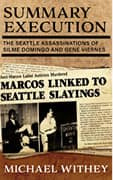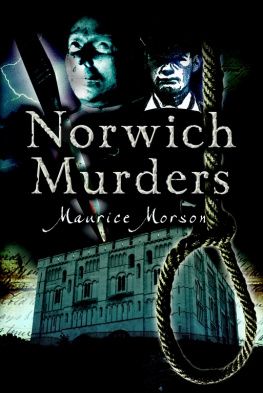GOING POSTAL
GOING POSTAL
Rage, Murder, and Rebellion
From Reagans Workplaces
to Clintons Columbine and Beyond
Mark Ames
2005 by Mark Ames
Design by Gary Fogelson Cover photo by Jacqueline DiMilia
Published by Soft Skull Press 55 Washington Street, 804 Brooklyn, NY 11201 www.softskull.com
Distributed by Publishers Group West 800.488.3123 | www.pgw.com
Printed in Canada
Library of Congress Cataloging-in-Publication Data
Ames, Mark, 1965
Going postal : rage, murder, and rebellion : from Reagans workplaces to Clintons Columbine and beyond / by Mark Ames.
p. cm. ISBN 1-932360-82-4
1. MurderUnited States. 2. Violent crimesUnited States. 3. United StatesSocial conditions1980 I. Title.
HV6529.A52 2005 364.15230973dc22
CONTENTS
The chimps are infected! Theyre highly contagious!
Infected with what?
Rage
28 Days Later
PART I
If Hed Just Got the Right People
I told them Id be back.
O N S EPTEMBER 14, 1989, Joseph Wesbecker, known as Rocky by his co-workers, inadvertently helped spark a bloody rebellion.
At just around 8:30 am, he pulled up to the Standard Gravure building in downtown Louisville, a 1920s-era printing press attached to the Louisville Courier-Journal . The severe rectangular building took up an entire block of Sixth Street between Broadway and Chestnut in the rundown city center. Wesbecker parked his red Chevy Monza hatchback at a meter just in front of Standard Gravures main entrance. He wore jeans and a tan jacket and his trademark tinted steel-framed glasses.
One witness who saw Wesbecker emerge from his car said that he was acting weird, in part because parking on that block of Sixth Street is prohibited until 9 am. She also said she saw him handle what looked like a package under a blanket in the back of his hatchback.
I was going to hold the elevator for him, she told the Courier-Journal , but Wesbecker stayed at his car so she rode up alone.
The street-level entrance that Wesbecker parked in front of led to the third floor executive offices of Standard Gravure. The main door to the elevator was left unlocked during work hoursonly the stairwell door remained locked. The entrance at one time had a mounted security camera above the door, but it was removed over the summer after having been repeatedly vandalized. In many of Americas midsized cities, downtowns have become like South Vietnamese hamlets: ours during the day, theirs at night.
The elevator went straight up to the executive reception area on the third floor. The other entrance, around the block on Broadway, led straight to the printing presses. That was the blue-collar entrance, the one Rocky would normally take. But on this day he didnt plan to work the printing press folder.
Wesbecker rode the elevator up, brandishing a Chinese-made AK-47 semiautomatic at his hip and packing a German-made SIG-Sauer 9mm pistol in his pants. Strapped around his shoulder was a gym bag (within a few years, thegym/duffel bag would be recognized as a standard-issue rage murder accessory), packed with two MAC-11 semiautomatic pistols, a .38-caliber Smith & Wesson revolver, and several rounds of ammunition, including five loaded clips for the AK.
The elevator door opened and Wesbecker immediately opened fire. His first two victims were receptionists Sharon Needy, who later died, and Angela Bowman, who was shot in the back and paralyzed from the waist down. Needy usually reported to work at 9 am, but on this day she showed up a half hour early so that she could take an extended lunch break. Bowman had given birth a few months earlier and had just returned to Standard Gravure from maternity leave. Wesbecker rounded the corner to the hallway of offices where the executive and managerial staff worked. Payroll administrator JoAnne Self, whose office was near the reception, heard the first two shots and stuck her head out the door. There she saw Wesbecker standing outside the office of Mike Shea, Standard Gravures new owner and president. Shea just happened to be away that day.
Wesbecker fired; Self didnt see where. She fled.
[Wesbecker] wasnt running, Self told the Courier-Journal . He was walking very slowly. But I ran. I ran and fell and crawled the rest of the way.
Self and three other employees hid at the end of the hallway in the office of data processing manager Mike Delph, who had managed to call 911.
Wesbecker walked slowly, firing deliberately. Police major Ed Mercer told reporters that day that Wesbecker showed extreme shooting discipline, firing directly at his human targets and taking few random shots.
Systems operator Kathy Johnson was at work in the computer room, around the corner from the reception area, when she heard a loud bang. She poked her head out to see what was happening when a co-worker sprinted by in a panic. Johnson closed her door and stayed in the computer room.
I was going to get in the closet, but it was locked, Johnson said. So I stooped behind the computer. She heard four shotsthen silence. Johnson quietly called the other offices in the hallway. One person answered, Paula Warman, the assistant to the vice president of human resources (the VP was gone that day along with Shea and the companys number-two man).
Warman, who had been shot in the legs, answered, Some of us have been shot. Some of us have been shot. As it turns out, Warman figured as one of the key players in a management-worker dispute that helped push Wesbecker over the edge.
Wesbecker moved from the white-collar office area down a long narrow hallway and into the third floor bindery. He opened the door and shot John Stein, a maintenance supervisor, in the head and abdomen. Two other maintenance workers in the bindery were also shot, Forrest Conrad, shot in the legs, and James G. Buck Husband, who was killed. When two female employees happened into the bindery a few minutes later, not realizing what was happening, they saw Stein bleeding from the head, leaning against the door.
One woman lifted Steins head and tried to put a shirt under it to comfort him. He grabbed the shirt out of my hand, the woman later told reporters before breaking down in tears.
From the third floor Wesbecker headed down a metal stairwell into the pounding dissonance of the pressroom. It was more crowded with workers thanusual because of the shift change at 9 am. Wesbecker shot and wounded two men in the bindery basement and killed another, Paul Sallee, who was found on the floor with a bullet wound in his chest.
Wesbecker crossed a tunnel to the basement of the pressroom. It was a large room cluttered with giant paper rolls, which look like huge rolling pins without the handles. Large aluminum ducts, ladders, and other printing equipment were cluttered together to form a kind of mid-twentieth-century industrial labyrinth. The bottom halves of the three printing press machines, which operated on the ground floor above, extended down into the basement.
Wesbecker entered the basement room just as John Tingle, a pressman whod heard a loud noise that sounded like a steel plate hitting the floor, rounded the corner to see what was happening.
Tingle knew Wesbecker and greeted him as if it was just another day, despite the smoking AK and the ominous duffel bag packed with guns and ordinance. Hey, Rock, whats happening? Tingle asked, using the friendly shortened version of Wesbeckers menacing-sounding nickname.
Wesbecker, who had always been on friendly terms with Tingle, replied, Hi John I told them Id be back. Get away from me.
I said, What are you doing, Rocky? Tingle later told reporters. I started to walk toward him, and he said, Get away. Wesbecker repeated himself, this time telling Tingle to get the fuck away. Tingle obeyed and motioned to the others nearby to move away.
Next page











